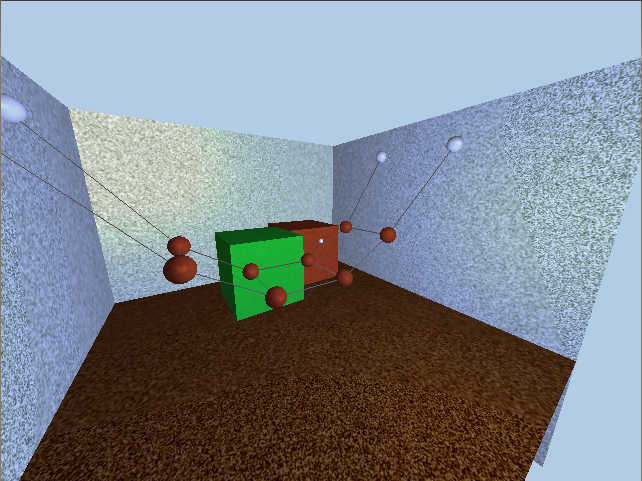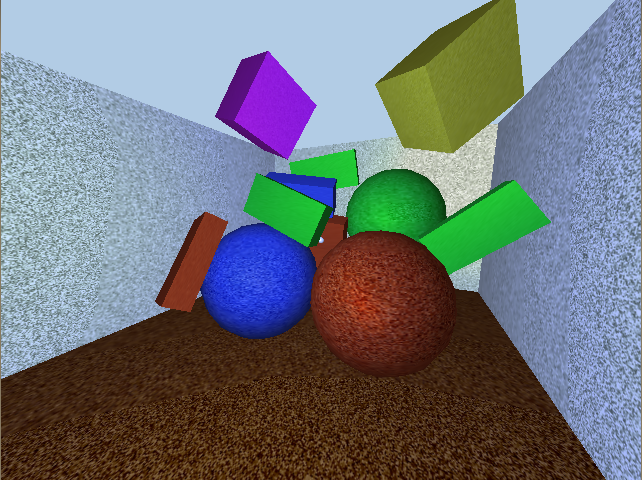PSE Game Physics - Summer 11: Difference between revisions
Jump to navigation
Jump to search
No edit summary |
No edit summary |
||
| Line 20: | Line 20: | ||
= Contents = | = Contents = | ||
A game physics engine is developed in this lab. | A simple game physics engine is developed in this lab. | ||
Starting with simple time steps for moving rigid body objects you will successively extend your developments by collision detection, rotations, friction, etc. to obtain a game physics engine. | Starting with simple time steps for moving rigid body objects you will successively extend your developments by collision detection, rotations, friction, etc. to obtain a game physics engine. | ||
| Line 31: | Line 31: | ||
* Resolving of interpenetrations | * Resolving of interpenetrations | ||
* Friction | * Friction | ||
* ... | * ... | ||
= Prerequisites = | = Prerequisites = | ||
* Preliminary knowledge in C++ is advantageous, but it's no prerequisite. | * Preliminary knowledge in C++ is advantageous, but it's no prerequisite. However, you should have experiences in object-oriented programming - e.g. Java programming. | ||
* No prior knowledge about visualization is necessary: A framework for visualization, interactivity and the interface for the physics is given. Thus you'll only have to implement the physics part. | |||
* No prior knowledge about visualization is necessary. | * Also no prior knowledge about physics is necessary. We'll give a short introduction to physics. | ||
Revision as of 14:58, 4 February 2011
- Term
- SS 11
- Lecturer
- Univ.-Prof. Dr. Hans-Joachim Bungartz,
Martin Schreiber,
Atanas Atanasov,
Philipp Neumann - Time and Place
- t.b.a.
- Audience
- Studenten der Informatik (Bachelor)
- Tutorials
- -
- Exam
- -
- Semesterwochenstunden / ECTS Credits
- 6 SWS (6P) / 10 Credits
- TUMonline
- {{{tumonline}}}
PRELIMINARY WEBSITE
Course is held in German, the slides are in English.
Timeline
- preliminary session: 10.02.2011, 10:00, room: t.b.a
Contents
A simple game physics engine is developed in this lab. Starting with simple time steps for moving rigid body objects you will successively extend your developments by collision detection, rotations, friction, etc. to obtain a game physics engine.
Topics:
- Introduction to game engines (Visualization, physics, scripting, ...)
- Game-Physics (Force, momentum, torque, ...)
- Game-Math (Numerical approximations, accuracy, time-steps, ...)
- Modeling of springs, Rods, Ropes
- Collision detection
- Resolving of interpenetrations
- Friction
- ...
Prerequisites
- Preliminary knowledge in C++ is advantageous, but it's no prerequisite. However, you should have experiences in object-oriented programming - e.g. Java programming.
- No prior knowledge about visualization is necessary: A framework for visualization, interactivity and the interface for the physics is given. Thus you'll only have to implement the physics part.
- Also no prior knowledge about physics is necessary. We'll give a short introduction to physics.
Preview
- Hanging Bridge simulated with ropes:

- Falling objects (Cubes, Spheres):

Timetable
t.b.a.
Worksheets, Material, and Lecture Notes
t.b.a.
Recommended Literature
- Game Physics Engine Development, Ian Millington
- Real-Time Collision Detection, Christer Ericson
- Game Physics, David E. Eberly